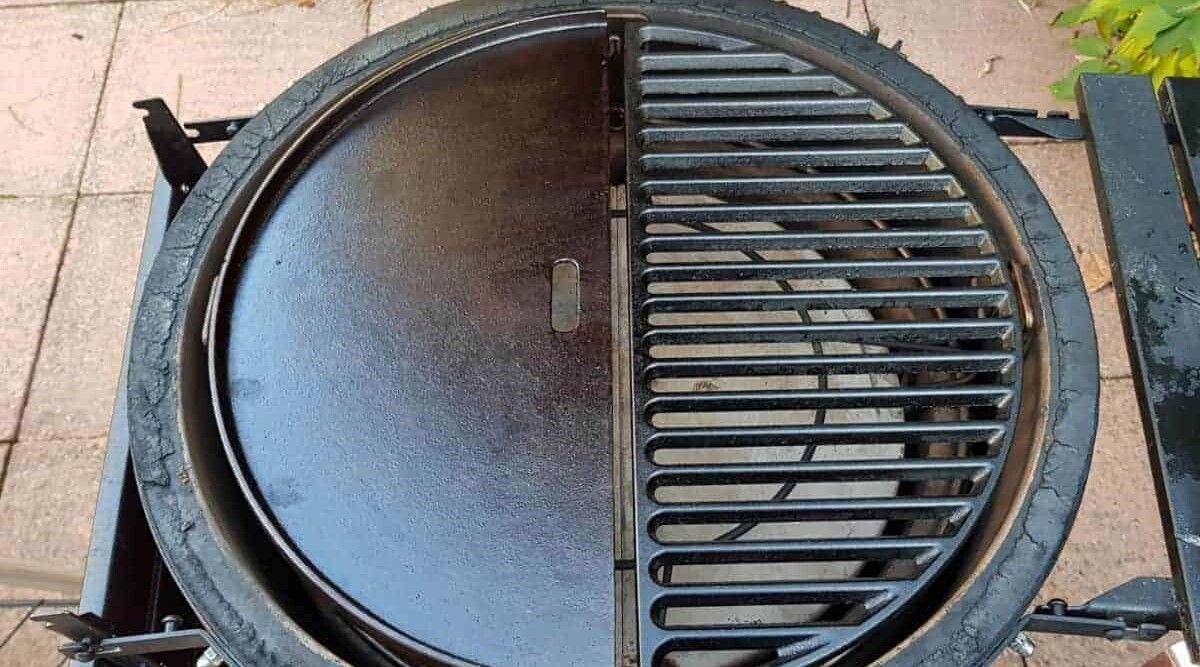
Did you cook last night’s steak and this morning’s pancakes on the same cookware? Of course not.
Most of us know when to use the appropriate cooking surface, pan or utensils after watching TV or learning from others. But, do you know the difference between a grill and a griddle? And why one cooking surface is more suitable than another?
I’m going to show you some interesting facts about griddles and grills, their differences and why they’re suitable for cooking different foods on each.
Griddles and grills are interchangeable for some foods, but not others, because of their different surfaces and how the heat is applied to the food cooking upon them, so this is important stuff to know.
Before we dive further into the discussion of griddle vs grill, let’s first go over the basic features of each.
Jump to:
What is a Griddle?
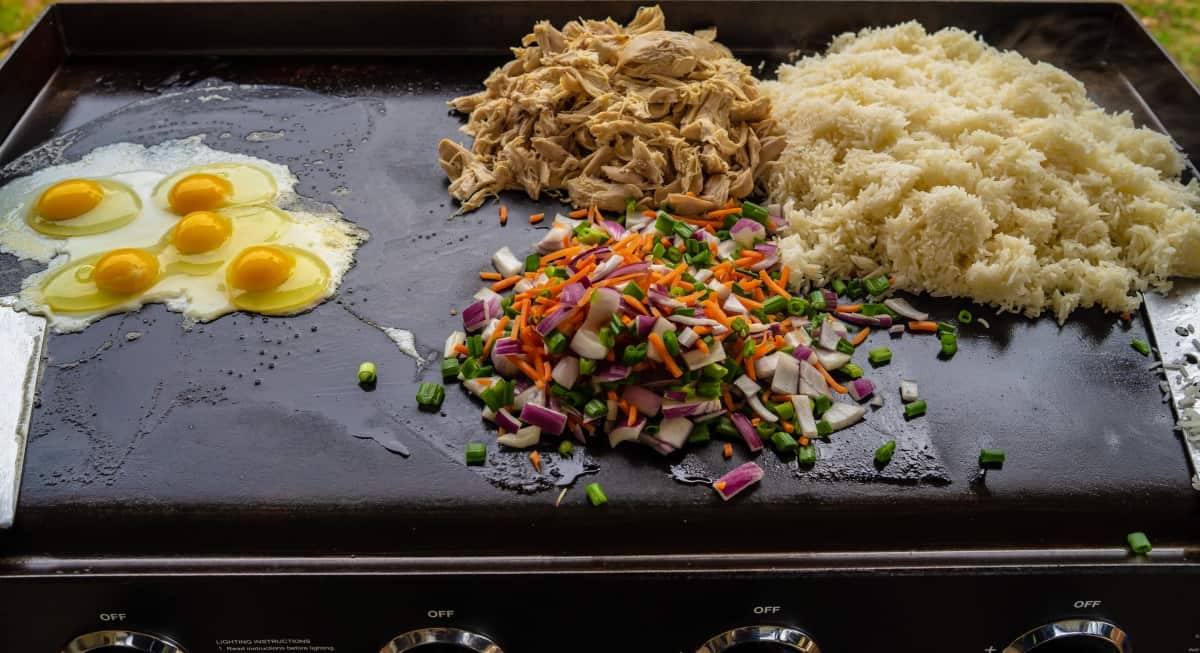
The griddle is quite like a hotplate, a flat, smooth metal surface with the heat source directly underneath. The food cooks directly on it. In other words, it’s pretty much nothing but a big frying pan without a handle or sides.
While most hot plates are round, griddles are mostly rectangular. The size varies depending upon use, indoor or outdoor, home or commercial cooking.
They can be large for restaurant use or small enough to fit into the center of a range top, between the burners. There are even tabletop models for making breakfast at the table anywhere there is an electrical outlet.
They can also be a simple flat piece of iron or steel that fits over a campfire or gas burner. The important characteristic of a griddle is that it remains level. Otherwise, liquids will run off to one side.
The thicker the metal, the better the heat retention and cooking quality. Also, thinner metals may warp creating an uneven cooking surface.
What is a Grill?
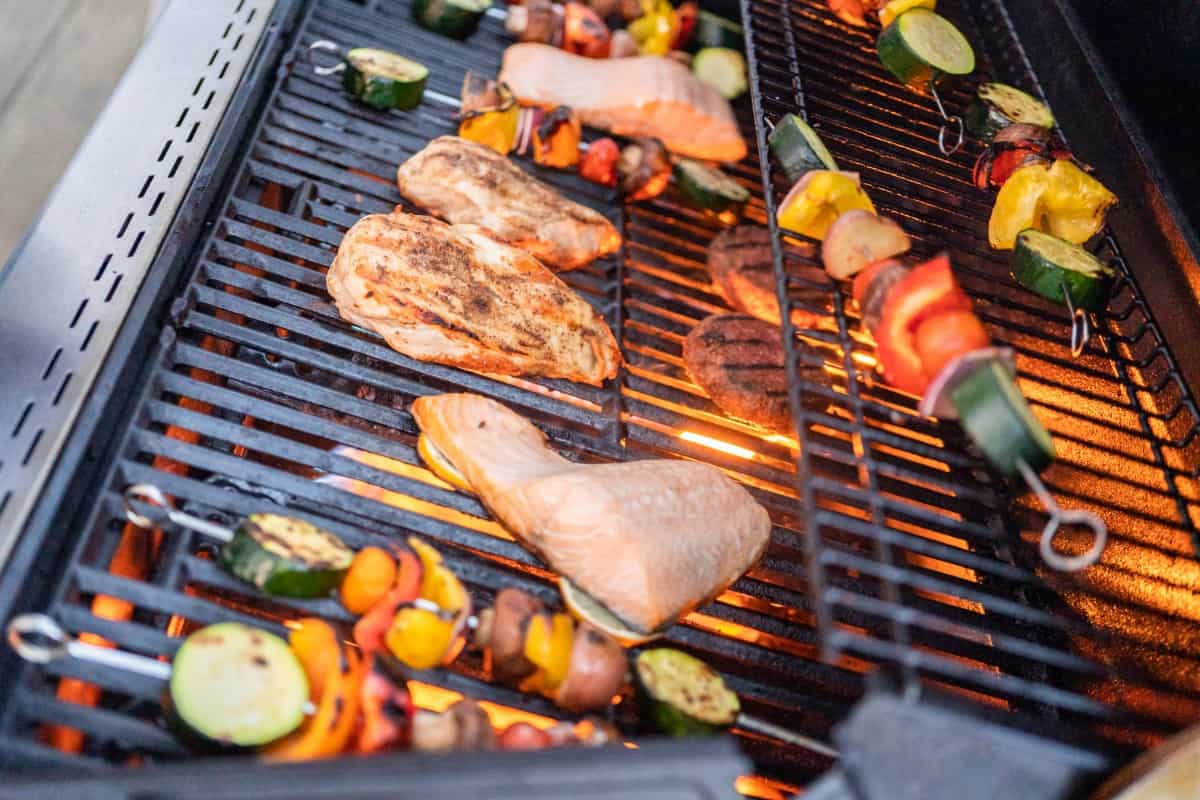
You’ll find two types of grills. One is a solid iron or steel plate with ridges, and the other is bars that hold the food directly over the open flame. The open type is what you see on most barbecue grills.
Solid grills have continuous rows of ridges that transfer the heat into the food while allowing the oil and grease to run down in-between them.
Grill cooked food has those delicious, little grill marks from the ridges or bars. The intense heat browns or blackens the food where it contacts the metal. The browning is called the Maillard reaction, caused by the sugars becoming caramelized from the heat.
Grills give off a lot of heat and smoke, and only used outdoors or underneath a commercial ventilation system that pulls the smoke outside.
Smokers cook at temperatures lower than barbecue grills or griddles, but the grates are open allowing the smoke to circulate and the juices to drip away from the meat.
What is the Difference Between a Griddle and Grill?
The difference is obvious. Griddles have smooth, flat surfaces. Grills have distinctively raised ridges if it is a solid plate, or bars with openings in between allowing food to cook directly over the heat source.
The heat source for either griddles or grills can be gas, charcoal or electricity.
Griddles transfer heat from the entire metal surface to the food, cooking and browning evenly. The heat source or flames never touch the food.
Grilling uses higher temperatures than griddle cooking. The heat transfers from the fire directly, and through the metal of the grill grate. The metal absorbs and intensifies the heat, browning or burning at the point of contact. These are the grill marks we love on our hot dogs and steaks.
Just think of how you make pancakes. If you can pour it onto the surface and make round flat pancakes, it’s a griddle. If there are bars with openings in between or a metal plate with raised ridges, it’s a grill.
The Type of Metal Makes a Difference
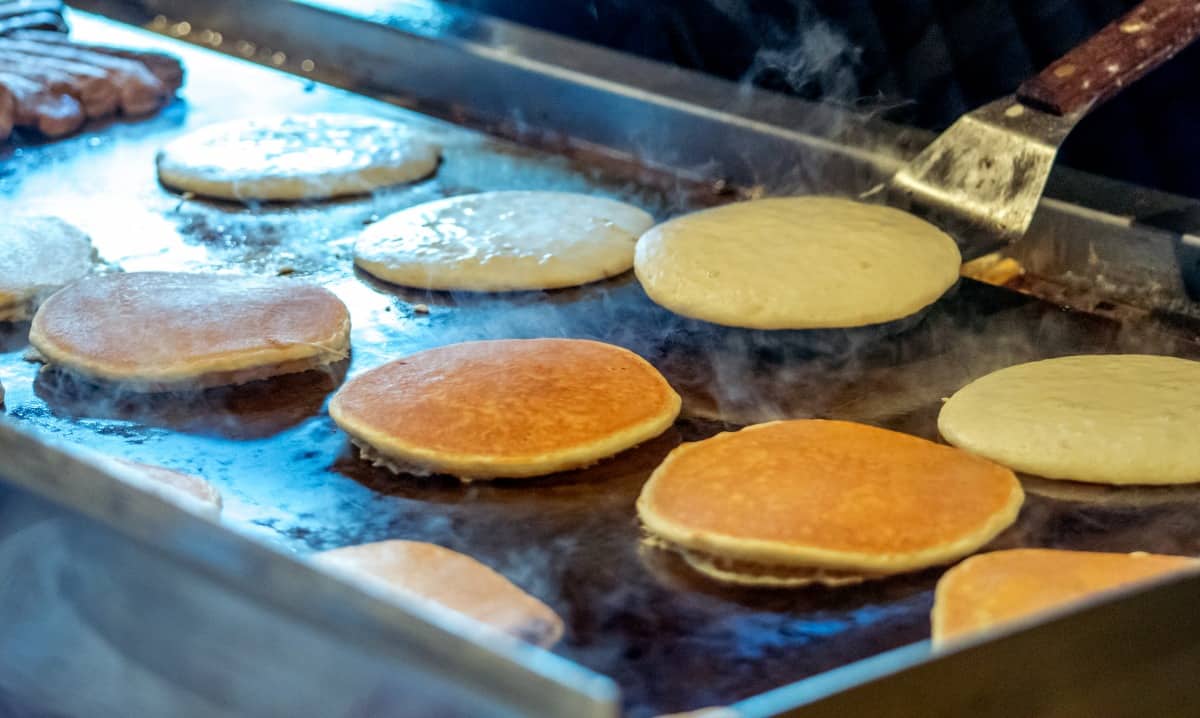
Most griddles will be either steel or cast iron. For bigger budgets and commercial use, you can get stainless steel and even chrome.
You’ll find steel or stainless-steel griddles in most restaurants and hotels. They mill the steel smooth to about 3/4-inch, and it weighs about 30 pounds per square foot. It won’t warp and has excellent heat retention and recovery.
You can also get 1/4-inch steel for plate material that weighs about 10 pounds per square foot. If you plan on cooking a lot of dense foods like burgers and potatoes, go with the thicker steel. If you are considering stainless, it’s more expensive, and a 1/4-inch piece weighs about 11 pounds per square foot.
You’ll find grill grates in a variety of different materials like nickel plated steel, stainless steel, cast iron, porcelain-enameled cast-iron and porcelain enameled steel.
The porcelain coating aids in clean up but does not add to the cooking process. As with griddles, the thicker the metal, the longer they retain heat and resist warping.
Although plain steel and iron can rust, once you break them in and ‘season’ them, they are almost non-stick. After cleaning, you just wipe on a little vegetable oil to prevent rust.
The bottom line here is the bigger and heavier, the better.
What Kind of Food is Appropriate for Cooking on Each?
You’ll mostly see flat griddles used for cooking breakfast items such as pancakes, French toast, hash browns and scrambled eggs. They also work great for cooking hot sandwiches and burgers too because you can toast the buns at the same time. You’ll find one in almost any kitchen in the world. For example:
- France — Crêpes and galettes(sweet and savory thin pancakes)
- India — Chapatti (whole grain flat bread)
- Spain — They cook almost everything à la plancha (grilled on a metal plate) using a griddle
- Malaysia — To cook stuffed roti breads like roti canai and roti “boom”
- Japan — Teppanyaki dishes
Grills are vital to every culture of cooking around the world. They work best for larger, robust cuts of meat, fish, poultry, sausages or whole vegetables like corn on the cob. Veggies just taste better grilled. Be sure to add a little oil first, or they tend to dry out.
Smaller pieces need to be skewered to keep them from falling through the grill like shish kabob and satay. The higher temperatures of grilling add an element of flavor beyond the basic ingredients.
What Are the Cooking Temperatures?
One of the biggest differences between a griddle and grill is the cooking temperatures. Grills cook at higher temperatures of at least 400 °F (204 °C) or above. Griddles work their magic around 350 °F (177 °C).
Because grills give off more smoke and heat, they belong outside or under a commercial hood ventilating system.
Griddles tend to be a little safer since the food is not in direct contact with open flames, there is no chance of a flare-up.
Which One is Easier to Clean?
The flat griddle is much easier to clean than a grill.
The grill has more surface area with nooks and crannies that hold onto burnt grease. You’ll need a stiff brush and soapy water to clean most grills. For griddles, warm water and a flat scraper usually do the trick.
Cleaning a Griddle
You can see a video of how to clean a commercial griddle here. The same principles and tips apply to cleaning one at home.
Cleaning a Grill
Cleaning a grill can be a bit messier compared to cleaning a griddle, especially if you cook over an open flame.
Because a grill has lots of little nooks and crannies, gaps and spaces for food to get into and carbonizes and solidify over time, it really can take some effort to clean them.
Here is a short video showing how to clean a solid cast iron grill plate.
Which Is Better, a Grill or a Griddle?
There is no right answer to this question. It’s like asking which is better, a spoon or a fork? The answer lies in what you’re eating and cooking. As I’ve mentioned, griddles work best for diced, small, runny food or batters.
You’ll want to cook fatty meats and skin on poultry with a grill. The fat can drip off and create extra smoke and flavor. Your food is a little healthier because it’s not sitting in grease and oils like on a griddle.
Those blackened grill marks add a unique flavor to everything you cook, and you can’t get them using a griddle.
You’ll need both types of cooking surfaces if you plan on cooking regularly. If you are just beginning to collect kitchen tools and appliances, look for a double-sided cast iron grill/griddle combination. It is an inexpensive way to be prepared for any recipe challenge.
Let us know if you’ve tried different cooking surfaces like enamel-coated iron or chrome. We would like to hear your results.
Happy grilling!


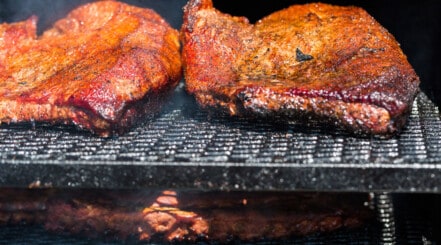
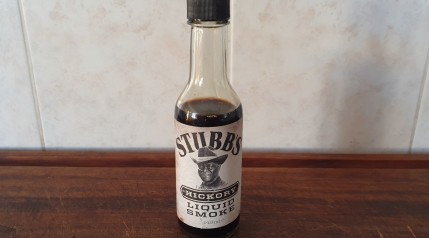
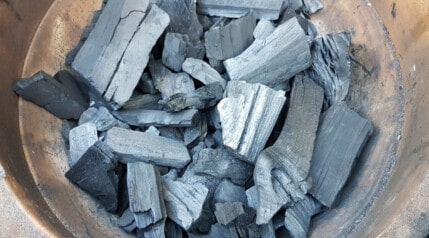
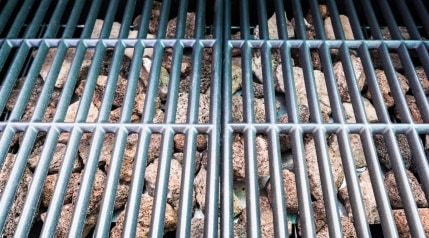
Thank you for the article. It was easy to understand and answered my questions around which way to go with my grilling/griddle equipment. You educated and helped me, as promised.
Thanks, Anthony. Glad it helped 🙂
Great article. I was totally lost, and you just answered every question I had.
Glad it helped 🙂
Where did you get the griddle part? It’s exactly what I need. Wanted a griddle to fit over my standard Weber grill grate.
Do you mean the one in the main picture, top of the post? That is the reversible cast iron grill and griddle from Kamado Joe for my classic version I. Google for ‘weber kettle plancha’ though, and you can find a griddle like surface that would suit.
I have been perusing your articles tonight after doing a Google search on the different cuts of pork and beef ribs and how to cook them. I am enjoying your straightforward articles as I like to cook but have not done any BBQ-ing except while camping on an open fire or using two little charcoal BBQs, one a bucket BBQ and the other a tabletop BBQ. Hence, I’m not very experienced at grilling meats nor come from a grilling family. I do more stovetop and oven cooking like stews, soups, roasts. So I intend to learn more about different cuts of meat and grilling methods. My husband comes from a grilling and BBQ family, but he doesn’t BBQ himself yet. For over a year now we have been subscribing to a local farm meat delivery service for grass-fed, organic, free-range meat products and can really taste the better difference compared to grocery store meats. They offer different meat cuts, so it’s good if we know what part of the animal that comes from and how to prepare it. One of these days we’ll buy a propane BBQ or maybe a combo smoker/BBQ. Do u have any articles about the pros and cons of grilling charcoal vs propane?… Thanks, again Mark for your info!
Hi Amanda,
Thank you for the kind words, nice to hear you’re enjoying the site. And good luck with your grilling and BBQ adventures, you’ve some great meals in your immediate future I’m sure 🙂
Yes, we have an article on ‘charcoal vs gas grills’. If you put that into the search at the top of the page, it will be the first result (I’d copy and paste it in, but I’m on mobile at the moment.)
Amanda here again. I also meant to mention that since we don’t have a real outdoor BBQ, I sometimes use my PC grocery store brand cast iron griddle pan, or my The Rock reversible metal-coated grill/griddle plate that fits on top of my stove burners. Both grill up steaks nicely, though of course, I have to keep my vent hood fan on high to suck up any smoke while cooking.
The Rock is easy to clean in hot soapy water in the sink, and doesn’t need to be seasoned as it’s already non-stick. But when cleaning my grill pan, I need first to soak it in my soapy dishwater (at the end) and lightly scrub with a green scrubby. Next, I rinse with warm water and let it drip-dry a few mins in the dish rack, then wipe off the outside with a paper towel (the exterior is enameled).
Next I put it back on the stovetop and try to medium heat for a few mins to dry off the inside. Once the water has evaporated and the pan looks dry, I drizzle one to two tbsp of high-cooking-temp vegetable oil, like avocado oil, and spread it all over with a basting brush, making sure to cover between the grill ridges plus the sides.
I turn the stove heat up a bit higher to medium-high and let the pan heat slowly until it starts to smoke to season it. I keep spreading around the oil with the brush as it does this.
After it smokes, I turn it off, let it cool completely, then wipe off the excess oil with a paper towel, ensuring that bits of the paper towel don’t stick to the rough iron coating inside my pan.
Sounds like you look after it well. I wish I was as responsible and caring with mine as you are!
This is by far the most awesome and informative post I’ve read on the subject so far. I’ve read 31. Thanks so much for this. I love it.
Thanks for all the info and links! At 73, I’ve cooked out over ALL types of fire both at home and with our Scout Troop. Right now, we have a weekly fundraiser at a “Cruise Night” every Friday during June, July, and August. Our old grill is pretty much “dead,” and we’re looking to replace it. So I thought I’d study up a bit.
I will probably go with a Weber quality grill that is portable, solid and able to be cleaned fairly easy.
One question: What about cleaning and seasoning the underside of the grill plates? Is it not necessary for some reason?
Thanks again,
DM
Hi Donald,
The underside of grates is directly exposed to naked flame (in most grills / griddles anyway), which causes any seasoning to burn off very quickly, so you are hardly ever able to build up a decent seasoning. However, when cleaning my grates, I always do the underside as it helps prevent corrosion. I especially make sure to do so if I know I will not be using those particular grates for some time because when I’ve not done so, I’ve had my cast iron rust.